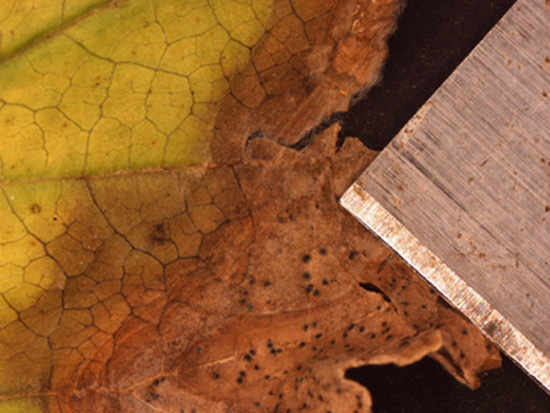Issue 12, July 17, 2009
Witchhazel Blight
If you investigate diseases that occur on witchhazel, generally you will find the statement that there are "none serious." I agree with that statement. This spring and summer, however, the statement has been challenged by the occurrence of some more severe blighting from this pathogen. The disease occurs in Illinois every year, but it appears more frequently and more severely in years with a wet spring. 2009 has provided necessary environmental conditions for infection.
Witchhazel blight is caused by a fungus, Phyllosticta hamamelidis. The fungus causes brown lesions bordered by darker brown margins. As the disease progresses it causes blighting of entire leaves. Literature reports that this fungus can cause leaves to die and can cause some stem tip dieback, but not death of the entire plant. The image shows a Plant Clinic sample of witchhazel blight submitted this summer. The second image shows the black fruiting bodies of the fungus embedded in the leaf tissue. The corner of a straight edge razor is in the picture for scale. The razor was used to remove some of the fruiting bodies to be examined with a microscope.


Fungicides are not listed in Illinois pest control manuals. I thought that this was possibly because the disease is minor in most years. As it turns out, I have searched the labels of products and find nothing that says it is cleared for witchhazel and controls Phyllosticta. It is best to find a fungicide that has a general ornamental label for leaf spot fungi. Maryland extension recommends Mancozeb (Dithane) or Cleary 3336 (thiophanate-methyl) which should offer control of this disease when applied in the spring as leaves first emerge. If you have the problem now, mark your calendar to consider spraying next spring. Meanwhile, rake and remove fallen leaves to reduce fungal inoculum. Prune surrounding plants to force more rapid drying of foliage. Make certain the label allows use on witchhazel.
Some work at the University of Maryland and presented through Maryland Extension shows differences in resistance of witchhazel cultivars to this pathogen. Results were published in the American Nursery Magazine, January 2006. Suggested resistant cultivars were Hamamelis mollis 'Early Bright' and 'Princeton Gold', H. x intermedia 'Primavera', H. vernalis, H. x intermedia 'Jelena' and 'Luna' and H. virginiana.--Nancy Pataky
Author:
Nancy Pataky